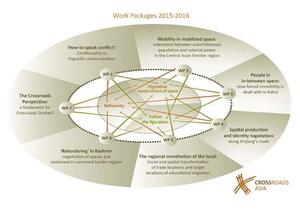Aim of the Network

An important subject of ongoing debates in international social sciences and humanities is that of how scholarship in and about particular regions ought to be conducted in a globalized 21st century, especially given the multi-scalar flows of people, goods and ideas. In this regard, conventional Area Studies have rightly been criticized for limiting their inquiries to fixed territorial ‘containers’ and for imposing a ‘Western’ worldview, as well as for neglecting to engage with the so-called systematic disciplines, for example, economics, sociology and anthropology.
It is as one response to these charges that the competence network Crossroads Asia calls for and tries to generate novel perspectives on inter-disciplinary Area Studies research. Comprised of six research institutions with regional expertise covering Afghanistan, Iran, Kazakhstan, Kyrgyzstan, Nepal, Northern India, Pakistan, Tajikistan, Uzbekistan and Xinjiang, the network aims to further an understanding of the interactions of individuals with a connection to places from eastern Iran to western China and from the Aral Sea to northern India. In doing so, it intends to contribute to overcoming the neglect of non-‘Western’ epistemologies, insights and forms of knowledge generation, as well as to close certain gaps between systematic disciplines and Area Studies.
The research within the network has centered on figurations, defined as specific causal and functional connections making up constellations (e.g., familial, religious, or economic networks). During the first funding phase of the project (2011-14), micro-level empirical research focused on figurations related to three thematic concepts: conflict, migration and development. Since early 2015, the network has begun a second funding phase in which there is a synthesizing of earlier research. We are beginning in-depth analyses of how spatial realities are constructed by the movement of people, goods and ideas, as well as how these emerging constructions – with their limiting borders and boundaries – enable and constrain mobility. Physical and social mobility, as well as imagined/mental mobility, are all considered in this context. Our overarching research questions include: What, in particular movement, makes borders and boundaries take on significance? In turn, what causes their meaning to be altered or even lost? Within and across limiting components (e.g., geographic, political, socio-cultural and/or ethnic borders and boundaries), which factors contribute to im(mobility)?
Based on this extensive research and diverse analyses thereof, we are aiming to collectively elaborate a Crossroads Perspective for understanding complex webs of ties and their spatial dimensions. This non-prescriptive selection of conceptual and methodological tools for rethinking how to conduct research on fluid, dynamic and complex phenomena will be articulated at our conferences and workshops, in publications including an Area Studies textbook, and in teaching, including at the new ‘Global and Area Studies’ graduate program at the Humboldt Universität Berlin, one of the network institutes. The Crossroads Perspective will consist of a methodological approach (‘Follow the Figuration’), as well as an ethical component, to guide Area Studies researchers in reflecting on their position in relation to their subjects, as well as the tangible impacts of the research they conduct. The Crossroads Perspective will also contain a tool-kit of concepts which have proven resilient in our empirical analysis of, for example, bordering processes in Kashmir; cross-border bazaar trade between Kyrgyzstan, Kazakhstan and China; and Baloch networks rooted in Afghanistan, Pakistan and Iran.
The figure below provides an overview of the current working groups comprising the Crossroads Asia Network. Additionally, follow the links below to read more about each working group.
Overview of Work Packages 2015 - 2016
Working group 1: 'How to speak conflict' - Conflictuality in linguistic communication
Working group 2: Mobility in mobilized space: Interaction between autochthonous population and colonial power in the Central Asian frontier Region
Working group 3: People in in-between space: how forced immobility is dealt with in Kabul
Working group 4: Spatial production and identity negotiations along Xinjiang’s roads
Working group 5: Social and spatial transformation of trade locations and target locations of educational migration: the regional constitution of the local
Working group 6: 'Rebordering' in Kashmir: negotiation of spaces and statehood in contested border regions
Working group 7: The Crossroads Perspective: a fundament for Crossroads Studies?







